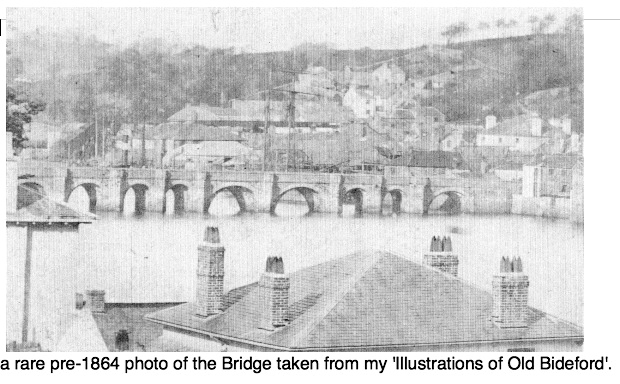As promised, and following on from my introduction to the Bridge Trust, I will discuss some of the history of the body. No-one knows when the Trust was set up but it must have been soon after the Bridge was built – so possibly at the end of the thirteenth century. Over the years rich Bidefordians have left property ‘to the Bridge’ (the last occasion was only two years ago!) to honour their native town and the Trust itself has been an active purchaser of property making it the largest local landlord (apart from Tarka Housing).
We have the Trust’s accounts from the end of the seventeenth century and the minutes from 1764. At this date there were some fifteen trustees, most of them being merchants or gentry, though some clergymen also served. I have transcribed, typed and indexed the minutes and copies are available in the North Devon Record Office. They detail the two main aspects of the Trust’s work – management of property and charitable spending.
The former was, of course, centred on the Bridge itself and the minutes reveal many occasions when quite large sums of money were laid out in repairs, whilst on other occasions warnings about possible damage were issued. In 1791, for example, the trustees wrote to a local merchant complaining about his cart that was so highly laden ‘as they think will injure the said Bridge’. Weight limits are nothing new.
In 1802 there is a note that ‘Some malicious persons have repeatedly thrown down the Coping Stones of the Bridge’ and so the trustees hired two men to act as ‘watchmen’. They even spent some money on a ‘Centry Box’ to house them. In 1808 the Trust carried out work on nine arches at a cost of £50 per arch, whilst a year later they discussed installing a drawbridge at the East end of the Bridge. This never occurred : in 1826 they erected oil lamps on the Bridge, but these were soon vandalised and in 1835 were replaced with gas lamps after the trustees allowed the new Bideford Gas Company to install gas pipes across the Bridge. The largest spending came when the old medieval structure was widened in 1864 and again in 1925 – to such an extent that it is difficult to picture what the old Bridge looked like.
In addition to this spending on the Bridge the trustees developed Bridgeland Street from the 1690s and extended the Quay up to their new development. They also built the original Bridge Buildings in 1758 which housed the town hall and the Grammar School. In 1761 they even purchased the Fox & Goose pub on the Quay (where Grenville House now stands) and gave it to the town as the Mayor’s ‘Mansion House’ – even if they later took it back!
In the 1880s they provided the town’s first custom-built post office in the High Street (now Ladbroke’s) and in 1882 spent £4,500 on building the new Bridge Buildings. Over the years 1890-1920 the Trust constructed the houses in Victoria Gardens, Marland Terrace and the top of Honestone Street.
In the twentieth century the two world wars interrupted this work, but in the 1990s the Trust refurbished the old Post Office, the Bakehouse in Queen Street, Friendship House opposite the Market as well as shops in High Street, Mill Street and Bridgeland Street. A proud record and one which shows how much the built environment in the town has depended on the Trust and its deep pockets.
In the next article I will look at what the Trust has funded in Bideford.
Peter Christie.
___________________________________________________

